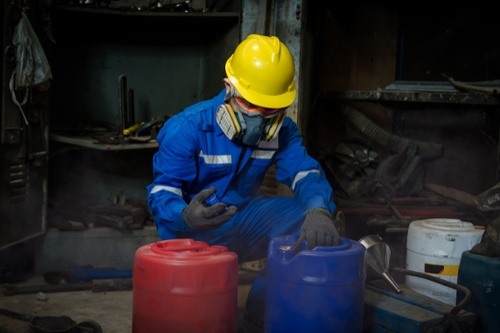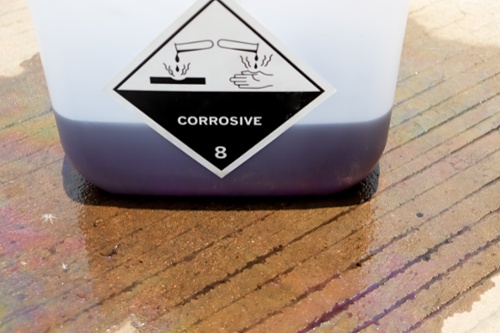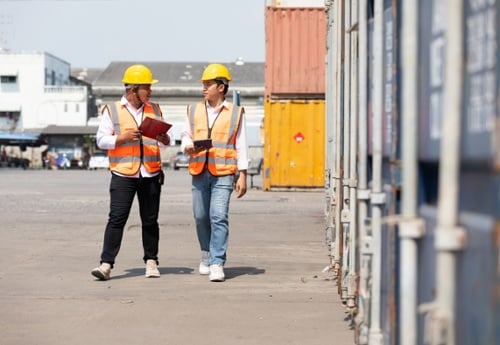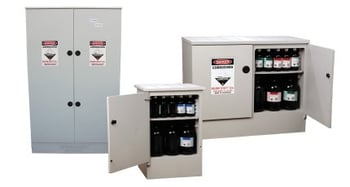With a unique ability to destroy and damage living tissue, metal, stone and other materials, Class 8 Corrosive Substances are a challenging hazardous chemical to have onsite. Whether they’re being used as an abrasive cleaning product in a mechanic’s workshop, as a neturaliser in a chemical lab, or within the production processes of a factory, corrosive substances are found across a diverse range of industries.
While they are a common feature in Australian workplaces, seemingly simple mistakes can be made when handling and storing corrosive chemicals that can have severe consequences. Read on to find out more about what not to do when carrying any type of corrosive substance in your business.
#1. Not Wearing The Correct PPE
Dangerous goods can affect human health through three main ways – inhalation, ingestion and coming into contact with the skin or eyes. In the case of Class 8 chemicals, corrosive substances can be powerful chemicals with the ability to corrode skin and eye tissue, as well as damage respiratory systems and digestive tracts.
Harm to human health may be acute (short term) or chronic (long term), depending on the length and type of exposure. Some acute health effects of Class 8 substance exposure may include headaches, nausea, vomiting and skin corrosion. Long-term chronic health effects may include cancer, nerve damage or asthma.

Without the correct PPE, corrosive substances can cause acute and chronic health affects if workers who are exposed to them.
When working with this type of chemical, personal protective equipment (PPE) is a must. But what types of PPE are required for corrosive chemicals?
While referring to the individual Safety Data Sheet (SDS) of each corrosive chemical is the first step in determining your PPE requirements, there are some general rules that apply.
Wherever corrosive chemicals are handled or stored, the following should be adhered to:
- All persons on the premises must be provided with the appropriate PPE
- It should be kept in an easily identifiable and accessible location
- PPE must be maintained to ensure effectiveness
The types of PPE required for handling corrosive chemicals include:
- Protective clothing (complying with AS/NZS 4501.2) must be suitable for use with the specific corrosive substance that is being handled by staff
- Eye protection (complying with AS/NZS 1337) must be supplied
- Protective gloves that are elbow-length (complying with AS/NZS 2161 must be supplied
- Safety footwear (complying with AS/NZS 2210)
- Respirators and self-contained breathing apparatus (complying with AS/NZS 1716)
By protecting themselves with well-maintained clothing, footwear, eyewear and breathing apparatus, staff can safely work with corrosive substances without risking damage to their skin, eyes or respiratory systems.
IMPORTANT: While PPE is essential for the safety and protection of staff, it’s important to refer to the Hierarchy of Controls when managing the chemical risks at your site. While PPE is the last option in the Hierarchy pyramid of controls, it should never be used on its own to minimise risk.
#2. Forgetting To Properly Secure and Stack Packages
While spillage is one of the most common hazards when working with hazardous liquids, spilling corrosive chemicals poses an immediate threat to staff, property, vehicles and the environment.

Understanding how to secure and stack your corrosive chemical packages is a key point in spill prevention.
Leaks, drips, minor spills and major spillage can cause severe damage to organisations, which is why the prevention of spills must be a key consideration.
Training staff to securely cap all corrosive packages is one way to reduce the risk of spillage. Another is to ensure that they’re loading and stacking your corrosive stores in a safe and compliant manner.
When working with corrosive chemicals, staff should be mindful of keeping packages in neat stacks that will not become unstable.
Heavier and larger packages should always be put at the bottom of the stack, so no undue pressure is placed on the bottom layer.
Also consider how you’ll be delivering and transferring your Class 8 chemical packages. When packages are being moved or stored, they can easily become unbalanced. If they happen to topple or tilt, a loose cap or lid could result in a corrosive chemical spill.
Class 8 chemicals will start to corrode materials and living tissue as soon as they touch the surface. So, it’s important to exercise extreme care when handling and storing corrosive substances.
In any areas where chemicals are decanted or transferred, secondary containment systems and PPE must be in place, to minimise the likelihood and impact of a spill. However, you must be careful to ensure that the bunding you have installed is made from materials which won’t corrode, such as PVC or polyethylene.
In any case, workplaces should develop an effective spill response plan to protect the health and safety of staff and visitors to your site. Choose a chemical spill kit that’s suitable for the corrosive product that you’re carrying, and make sure that your spill response team are properly trained to carry out the safe clean-up and disposal of corrosive spillage and resulting effluent.
#3. Not Segregating Acids From Bases
Whlie you’ve probably heard about the importance of chemical segregation, you may not be aware that some classes of dangerous goods – such as Class 8 Corrosive Substances – must be reviewed to ensure that products within the class are compatible.
When it comes to storing or handling acids and bases, you must always ensure that these two types of corrosives are kept apart.

Educate workers to understand the hazards associated with incompatible substances, such as Class 8 acids and bases.
Incompatible substances must be kept in separate storage facilities or stored in a cabinet that provides adequate segregation.
Acids and bases, if mixed, can cause highly exothermic reactions which are capable of causing an explosion and generating harmful gases. Always educate staff about the dangers associated with incompatible substances and ensure your storage facilities allow for the safe segregation of Class 8 acids and bases.
#4. Allowing Spillage To Sit
Does your workplace have strict procedures in place which encourage staff to notify supervisors about corrosive leaks and spills – as soon as they occur?
Even if your spillage occurs in a bunded area or within a corrosive substance safety cabinet, it’s important that the spillage is cleaned out and disposed of as quickly as possible.
Many corrosive substances can produce large amounts of corrosive vapours, which can affect the breathing quality of air in the chemical handling or storage areas.

Corrosive liquids and vapours will be released when in the event of an accidental release, so a prompt spill response is necessary.
The corrosive substance itself, while contained in a chemical resistant bund, must be cleaned out so the bunding remains at the compliant capacity.
By leaving spills and leaks sitting in your bund, you’re not only putting other staff at risk, but you’re compromising the effectiveness of your spill containment system.
REMEMBER: Cleaning out bunds in corrosive chemical stores relies on the use of the correct absorbent materials from your chemical spill kit. Make sure you soak up the chemicals in the bund, as well as wipe out all areas of the cabinet to ensure that the chemicals have not splashed onto walls, doors or shelves – and that no residue remains. Then, neutralise and/or decontaminate the area with the appropriate products that are suitable for your specific chemical product.
#5. Choosing The Wrong Cabinet Material
While other classes of dangerous goods may be able to be stored in a cabinet that’s manufactured to meet the requirements of that class, it becomes a little more complicated when you’re dealing with corrosive chemicals.
Highly corrosive vapours can corrode the sheet steel construction of regular Class 8 cabinets. Therefore, highly corrosive substances must be stored in a cabinet that provides complete protection against these corrosive vapours.
A polyethylene cabinet is made from high density polyethylene, which is chemically resistant to corrosive vapours. This type of cabinet is suitable for highly corrosive substances, while less potent chemicals can be stored in a metal Class 8 cabinet.

Choosing the right type of corrosive chemical cabinet will help you protect your workplace, as well as increase the longevity of your DG storage equipment.
If your chemicals aren’t highly corrosive, then they probably won’t produce sufficient vapours to corrode sheet steel. Therefore, you can safely store these types of chemical products in a metal Class 8 chemical cabinet that meets the requirements of AS 3780 – The storage and handling of corrosive substances.
Our metal corrosive cabinets are made from durable sheet steel. They’re equipped with chemical resistant spill trays and sump linings, to protect your equipment from leaks and spills.
REMEMBER: Before purchasing a corrosive cabinet, refer to the Safety Data Sheet of your chemicals to determine how corrosive your chemicals are. When in doubt, speak to a Dangerous Goods Specialist who can guide you towards the appropriate cabinet for your Class 8 products.
Simple Safety Tips For Class 8 Handling and Storage
While we’ve mentioned 5 mistakes that staff can make if your organisation is carrying Class 8 chemicals, there are many more things to consider when reducing chemical risk. One of the simplest ways to minimise risk is by having dedicated storage for everything in your workplace – from your acids to your bases, and your Safety Data Sheets to your personal protective equipment. By maintaining an organised workplace with compliant cabinets, staff are better prepared for their daily duties. They will also have immediate access to equipment and important documents, when they’re required in the event of an emergency situation, such as a corrosive substance spill.
If you require assistance with corrosive chemicals or any class of dangerous goods, why not access our free eBook? The Risk Assessment Process For Hazardous Chemicals explains our simple 4-step risk control methodology, which can be easily applied to any workplace. Grab your copy of our guide today by clicking on the below image.
Joining the team as a Dangerous Goods Storage Consultant, Melissa Hampton became Storemasta's Marketing Manager in late 2021. With extensive knowledge and experience in chemical compliance, Melissa is responsible for leading the Marketing team and helping shape their marketing strategy. In her spare time, you can find Melissa hiking, swimming and enjoying the great outdoors in beautiful north-west Tasmania.
